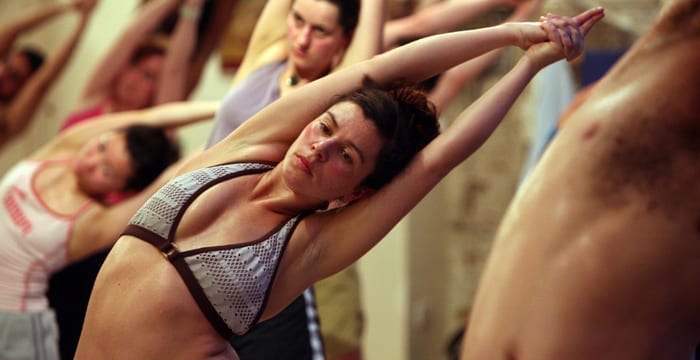Bikram yoga, or hot yoga, has become insanely popular over the last few years. Chances are, there’s a studio that offers it in your city or town. But a new study suggests it may not be as safe as yogis believe.
A new study, sponsored by The American Council on Exercise and published in the Gundersen Medical Journal, found that the intensely hot yoga class may raise some people’s heart rates and body temperatures to dangerously high numbers.
John P. Porcari, Ph.D., and his team of researchers at the University of Wisconsin—La Crosse’s Department of Exercise and Sport Science, studied 20 seemingly healthy adults (seven men, 13 women) who regularly practiced Bikram. Before participating in a Bikram yoga class, they all swallowed a core body temperature sensor and strapped on heart rate monitors.
After recording these vitals throughout the 90-minute class, researchers found that heart rate varied depending on the pose, but core body temperature steadily increased throughout the class. The average highest core temperature was over 103 F for men and102 F for women. One male participant had a core temperature of 104.1 by the end of class. Seven other participants had a temperature over 103. According to both The National Athletic Trainer’s Association (NATA) and the American College of Sports Medicine (ACSM), exertion-related heat illness and heat stroke can occur when your core body temperature reaches 104. Fortunately, none of these subjects exhibited signs or symptoms of heat intolerance, but the risk is there.
READ MORE: Can We All Agree That “Snowga,” or Yoga in the Snow, Is Kinda Crazy?
Many people choose hot yoga, because the excessive sweating they do from practicing in a room heated to 105 F with 40% humidity is said to flush toxins from the body. Sweating more also makes it feel like you’re getting a better workout. But sweating’s main purpose is to cool down the body when it’s overheating — this study proved that even with all the sweating, the body still can’t cool down enough in this environment.
Study leader Emily Quandt, M.S., also points out that a Bikram class isn’t focused on cardio training, which makes the high body temperatures and heart rates a little out of place. Said Quandt: “The dramatic increases in heart rate and core temperature are alarming when you consider that there is very little movement, and therefore little cardiovascular training, going on during class.”
The researchers suggest cutting classes to just 60 minutes — that’s when participants started to experience dangerously high body temps — instead of the standard 90. They also note the benefits of lowering the room’s temperature.
But you can’t really waltz into class with your yoga mat demanding things change around here. So what can you do if you don’t want to give up practicing? Drink more water. Many instructors may only give designated times for water, but do what you have to do. Staying hydrated is key in any vigorous, heart-rate-raising activity, and shouldn’t be any different in yoga.
READ MORE: Montana (Thankfully) Fails to Pass Yoga Pants Ban




































